Introduction
Vegetables are essential for human health because of their phytochemical compounds, especially antioxidant vitamins and minerals. 1 They are necessary for organisms’ metabolism and energy exchange. Sauropus androgynous L. Merr belongs to the Euphorbiaceae family, widely distributed in Southeast Asia and South Asia. 2 It seemed to have originated in Borneo’s hot, humid lowland rainforest. Its current range extends from India and South China, via Indochina and Malaysia, to the Philippines, New Guinea, and the Solomon Islands. It is growing intensively at lower altitudes and grows up at 1300 m in Malaysia and Indonesia. A species first discovered in Indonesia, Malaysia, Singapore, Papua New Guinea, Philippines, China (Guangdong, Guangxi, Yunnan, and Hainan), Bangladesh, Nepal, Myanmar, Cambodia, Thailand, and Vietnam. 3, 4
S. androgynous is distributed from northern to southern Vietnam. However, the plant is cultivated chiefly in Vietnam’s northern provinces. It is named Rau ngot, Bo ngot, or Bu ngot. In hot-humic conditions of the tropical climate, the plant proliferates. When referring to many Asia authors’ observations, the plant that grows in Vietnam has similar botanical characteristics. The stalks of the S. androgynous plant usually grow into a bush. From the main stem grow small branches. Plants in optimal cultivation conditions can reach 1.5-2 m tall. During the growth and development period, the trunk and small branches are green, and the bark changes into light brown when the plant is old. S. androgynous leaves are green, glossy, oval at the end of the leaves, and alternate. The leaf length and width are 4-6 cm and 15-30 mm, and the petiole is very short (1-2 mm). The old leaves are dark green. 3, 5, 6 S. androgynous flowers are red with a bit of purple, with many small petals, pistils, and stamens in the middle of the dark yellow petals. Spinach flowers have male flowers growing below the axilla leaves, while females grow above and develop into a fruit. The fruit is a white and small round, has a green stalk about 1 cm long, usually grows under the leaf axils, inside the fruit contains tiny seeds. 7
S. androgynous is a necessary part of the system of traditional phytotherapy. Indonesians traditionally use the leaf extract of S. androgynous leaves to increase breast milk production. 6 Malaysians use S. androgynous leaves to treat fever and urinary infection and improve milk production. 7 Indians use the leaves to treat blurred vision, tonsillitis, eye diseases, wound healing, and anti-diabetic aid. Additionally, the Chinese use plant branches and leaves to treat hepatitis, laryngitis, enteritis, constipation, cough, blurred vision, and plant roots to treat dysentery, lymphatic tuberculosis, and scabies. 2
Vietnamese people have been using the leaves of S. androgynous for one hundred years ago as a vegetable and traditional herbal medicine. As a vegetable, the local people cook it with minced pork or minced beef to make soup. In traditional medicine, “Thuoc nam”, the leaves after boiling are used to remove the placenta after delivery, allow post-partum recovery, and increase breast milk production at the time of lactation. Leaf juice from the plant is used to apply thrush orally to infants, affecting fungi Candida sp.
The bioactive compounds found in plant leaves include terpenoids, steroids, tannins, phenols, alkaloids, flavonoids, fatty acids, and volatile oils. 8, 9 The leaf extract of S. androgynous also contains a high concentration of vitamins (including vitamin A, B-group vitamins) and minerals (including Na, K, Ca, P, Mg, Mg, Zn, Fe, Cu, etc.). The leaves’ high vitamin content has been labelled “multivitamin” plant. 2 Due to its high antioxidant phytochemicals and vitamin content, S. androgynous would be an essential plant in pharmaceutical formulations and play a vital role in enhancing human health by contributing to antioxidants against free radical production. 9
In general, it is well-known that storage conditions and processing values can significantly affect the level of various compounds in green leafy vegetables, including S. androgynous. Therefore, the study aimed to determine the change of water-soluble vitamins (B1, B3, B5, B6, B9, C) and mineral elements (Na, K, Ca, P, Mg, Mn, Zn, Cu, Fe) by traditional Vietnamese method of preservation (cooling) and pretreatment (with rub and non-rub the leaves) before thermal processing (boiling).
Material and method
Material
The vegetable of S. androgynous was harvested from October to March in Binh Dương province (Vietnam). Harvested vegetables were packed in cartons and shipped quickly to the laboratory. The previous experiment was eight weeks apart from the following experiment.
Preparation for storage: The 200 g of S. androgynous were put in polythene zipped bags with holes (Figure 1) used for vegetable preservation in every system supermarket in Vietnam and stored at a temperature of 6.2±2.89oC and moisture 49±13.23%. After every 2- days of storage in the refrigerator, the vegetable samples were taken for treatment and determination of the content of the investigated vitamins (including vitamins B1, B3, B5, B6, B9 and C) and minerals (Na, K, Ca, P, Mg, Mn, Zn, Fe, Cu).
Preparation for processing: Plant materials were split into 2 portions: the edible and the inedible. Approximately 200 g of the edible portions were washed thoroughly with 3L of tap water to remove dirt dust. The water was boiled in a Becher (2000 mL) to 90-100°C, where the leaves’ samples at a ratio of 1:4 (water: material, v/w) were added in and kept for 15 min. After that, the leaves were processed according to two traditional pretreatment methods before thermal processing: rub and non-rub the leaves.
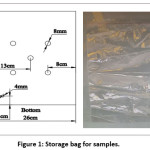 |
Figure 1: Storage bag for samples. |
Method analysis
Analysis of the nutritional composition
The nutritional composition of the S. androgynous leaf samples was analyzed as previously reported. 10 The moisture of the leaves was estimated by drying them at 105oC for 4 hours to a constant weight. After evaluating the moisture content, the sample was carried to determine the crude lipid content by extraction in petroleum ether (80°C) in a Soxhlet system for 4 hrs. After being free of moisture and fat, the sample of the leaves was treated with 0.255 M acid sulfuric (H2SO4) and 0.313 M sodium hydroxide (NaOH); then was washed with water and ignition the residue to determine the fibre content. The crude protein content was determined by the micro Kjeldahl method. Ash content was determined by heating plant samples in a muffle furnace for about 4-5 hours at 525 ± 25oC. 11
Preparation-processing method
Preparation method based on the method of Imaobong Udaosoro et al. (2013) with slight modified: Sample treatment: S. androgynous was only collected leaves and then divided into two parts, each weighing 200 grams. Wash the leaves with water to remove impurities and dirt on the leaves, and wash the vegetables twice with a volume of 3 liters of water each time.
Preliminary processing process: After being washed, the leaves will be processed according to two traditional methods: Rub and Non-rub. The leaf samples were crumpled by hand for 2 minutes. Water is boiled in the Becher in a ratio of material: water = 1:4 (by wt.). Leaves were heated at 90-100C for 15 minutes. How to conduct vegetable heating: Water is boiled in Becher (2000 mL) to 90 – 100 °C, in which leaf samples at a ratio of 1:4 (water: material, v/w) are added and kept for 15 minutes. After that, the leaves were treated according to two traditional preliminary processing methods before the heat treatment of “rubbing” and “no rubbing” to assess the loss of vitamins (B1, B3, B5, B6, B9) compared with fresh leaves 12.
Analysis of water–soluble vitamins
Standard solution preparation
Approximately 10 mg of each standard was dissolved in 4 mL of HCl 0.1 M in a 100 mL standard volumetric flask to make standard stock solutions of vitamins (C, B1, B3, B5, and B6). To prepare standard solutions of vitamin B9 as following each standard (10 mg) was dissolved in 4 mL NaOH 0.1 M in a 100 mL standard volumetric flask, which was kept at 4oC. Phosphate buffer (1 M, pH 5.5) was used to prepare the standard solutions. The dilution concentrations were 2; 4; 6; 8; 10; and 12 (ppm), respectively. 10
Sample solution preparation
Before being injected into the HPLC system, analytical samples were filtered through a membrane with pore size of 0.45 μm. The 1 g sample was then added to 1 mL of NaOH 0.1 M and 10 mL of phosphate buffer (1 M, pH 5.5). They were then kept for 24 hours in the dark. Use a 0.45 μm filter to filter the clear solution. The filtrate was transferred to a 25 mL volumetric flask and then replenished with HPLC feed water to the desired concentration for analysis. The sample’s stock solutions were retained in the refrigerator for future use. 13
HPLC analysis of water-soluble vitamins
Water-soluble vitamins were analyzed by HPLC apparatus according to the previously reported method 10 with slight adjustments. The equipment HPLC (Prominence-I LC-2030C 3D, Shizmadu, Japan) estimated the quality of vitamins, Shimadzu LC-2030C 3D on column (Shimadzu Shim-pack GISTC18; 250 mm × 4.6 mm; particle size 5 μm). Solvent A was acetonitrile serving as the mobile phase, and solvent B was trifluoroacetic acid (TFA, 0.01%, v/v). The sample volume injected into the column was 10 μL, and controlled the column temperature was at 30 °C. Carry out the elution along the gradient elution by varying the ratio of solvent A to solvent B. The gradient elusion was from 5 to 10% A with a flow rate of 0.8 mL.min-1 in 0–3 min, 10% A with a flow rate of 0.8 mL.min-1 for 3–10 min, from 10 to 12 % A, with a flow rate of 0.5 mL.min-1 for 10-12 min, and 20% A with a flow rate of 0.8 mL.min-1 in 12-14 min. The conditions for the mobile phase to back to its original state were as follows from 20% to 5% A in 14-18 min, 5% A in 18-20 min, at this condition allowing the sample to run for 1 min before injecting another sample into the column.
The standard of the vitamins was prepared at different concentrations (20, 40, 60, 80, and 100 μg/ml), and then the standard solutions were injected into separate HPLC columns. Record retention times and maximum absorption spectra of the compounds collected to determine the vitamins in the samples. Use a photodiode array UV detector at four different wavelengths, such as 254 nm (vitamin B1, B3, C), 275 nm (vitamin B6, B9), and 210 nm (vitamin B5), for chromatographic detection. HPLC Chromatograms of all vitamins were analyzed.
Analysis of minerals
Sample solution preparation
Samples previously prepared for storage and processing. Then, it was dried at 106oC to a constant weight. The dried vegetables were carried to the mill. Exactly 5 g of the dried sample was digested with 50 mL of HNO3 6 M in a digestion flask for approximately 12 hrs to ensure complete sample digestion. The digested samples were cooled to room temperature, filtered with Whatman filter paper, and diluted to the mark with triply deionized water in a 25-mL volumetric flask. The filtered solution was used to determine the mineral quantity. 14
ICP-MS analysis of minerals
This solution was finally used for elemental analysis, performed with an ICP- OES equipped (ICP-OES: SPECTROBLUE) with a concentric Nebulizer, a quartz torch with quartz injector tubes a cyclonic spray chamber. The content of mineral elements (Na, K, Ca, Mg, Mn, Fe, Cu, and Zn) were determined in vegetable samples. 15
Statistical analyses
The data were analyzed using a one-way analysis of variance (ANOVA). Data were expressed as Mean±SD of three replicates for all experiments. The differences were considered significant using Least Significant Difference’s test (P < 0.05) using Statgraphics Centurion XV software (Statgraphics Technologies, Inc., USA).
Results and Discussions
Nutritional composition of Sauropus androgynous
The sample was calculated based on the dry weight of the plant’s leaves, which have a high protein content, are a good source of dietary fibre, and contain a small amount of fat (Table 1).
The obtained results show that the nutritional compositions of the leaves are approximately the same as those obtained in the study, with moisture values ranging from 69.9 to 89.9%, protein from 3.4 to 29.2%, fat from 1.1 to 4.6%, fibre from 1.2 to 8.2%, and ash from 1.4 to 12.1%. 5, 16 Differences in nutrient amounts in the same food ingredients from different sources may be due to harvesting time, geographical location, or soil type. 17
Table 1: Chemical compositions of S. androgynous leaves.
| Component | % FW | % DW |
| Water | 79.41±0.31 | – |
| Protein | 5.37±0.2 | 24.05±0.87 |
| Total ash | 1.8±0.03 | 8.74±0.24 |
| Fibre | 1.4±0.23 | 7.21±1.19 |
| Lipid | 0.82±0.02 | 4.20±0.02 |
Mean ± SD representation value of 3 replicates. Note: FW: Fresh weight; DW: Dry weight.
Changes of water-soluble vitamins and minerals in the leaves of S. androgynous during the storage period
The samples of S. androgynous were put in polythene zipped bags with holes and stored at a temperature of 6.2±2.89oC and moisture 49±13.23 %. After every 2, 4, 6, and 8- days of storage in the refrigerator, the vegetable samples were shown in Figure 2.
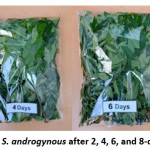 |
Figure 2: Plant S. androgynous after 2, 4, 6, and 8-days of storage. |
Changes of water-soluble vitamins during the storage period
S. androgynous leaves have a higher concentration of water-soluble vitamins than many other green leafy vegetables. The summary results of the quantitative analysis of water-soluble vitamins during the storage period are presented in Table 2 and Figure 3.
The study reported that the leaves of S. androgynous had a low ascorbic acid (vitamin C) content (7.26±0.78 mg/100g DW or 1.29±0.16 mg/100g FW) that decreased slightly during storage (5.94±0.56, 5.55±0.53, 4.23±0.01, and 2.24±0.44 mg/100g DW after 2-, 4-, 6-, 8-days respectively). Compared to other studies. 9 the amount of ascorbic acid in S. androgynous fresh leaves samples was much higher (298.32±0.34 mg/100 g FW). One of the reasons for this variation is the difference in usage of the extraction method. The wide range decrease of ascorbic acid in leaves of S. androgynous was 61.92 % after 8 days (compared with 0-day). It may result in ascorbic acid being oxidized to dehydroascorbic acid in fresh plant leaves throughout the storage time (In plants, these compounds act as a protective agent against various types of oxygen; moreover, they also can regenerate tocopherols). Vitamin C may also have a role in preventing the enzymatic browning of green leafy vegetables during storage. 18 Moreover, ascorbic acid content decreased during storage could be relative to the creation of NADPH, and/or the activity of monodehydroascorbate reductase was not enough to restore all monodehydroascorbate to ascorbate. 19
Among water-soluble vitamins, pantothenic acid (vitamin B5) in the fresh leaf samples was more abundant than B1, B3, B6, B9, and vitamin C (62.69±16.02, 123.39±19.45, 1.25±0.50, 42.21±2.12, and 7.26±0.78 mg/100g DW, respectively). The content of vitamin B5 of the sample was high (1224.43±31.18 mg/100g DW), and it substantially decreased in shelf lifetime: 2-days (12.37%), 4-days (30.1%), 6-days (57.18%) and 8-days (65.40%), respectively, when compared with initial samples.
Vitamin such as thiamine (vitamin B1) in the S. androgynous sample plant reached a level of 62.69±16.02 mg/100g DW on the first day of the storage period. Comparing the results with previous research 9 showed that the amount of thiamine in the S. androgynous fresh sample from Vietnam is significantly higher (0.043±0.025 mg/kg DW) than in the S. androgynous from India because of the different extraction methods and different locations. According to the data in Table 2, thiamine changes significantly during 8-days of storage.
The amount of niacin (vitamin B3) in the sample plants was higher than that of thiamine. After 2-days of storage, niacin (vitamin B3) increased substantially (from 123.39±19.45 mg/100g DW to 203.75±3.94 mg/100g DW), then decreased slightly every 2 days after that, reaching 177.44±2.35, 143.84±8.54, and 105.18±6.27 mg/100g DW after 4-, 6-, and 8-days of storage, respectively. According to another study. 18 the increments can be associated with microbial growth in samples. Furthermore, the synthesis of this vitamin in the post-harvest process could also be the reason for the increase.
Table 2: The content of water-soluble vitamins from the leaves of S. androgynous sample during storage.
| Vitamin(mg/100g DW) | Time of storage (days) | ||||
| 0 | 2 | 4 | 6 | 8 | |
| B1 | 62.69±16.02d | 49.63±1.84cd | 40.41±4.64ab | 33.74±2.05ab | 23.87±1.57a |
| B3 | 123.39±19.45ab | 203.75±3.94d | 177.44±2.35c | 143.84±8.54b | 105.18±6.27a |
| B5 | 1224.43±31.18d | 1072.97±85.48c | 855.90±64.08b | 524.30±9.37a | 423.70±53.35a |
| B6 | 1.25±0.50c | 1.04±0.23bc | 0.77±0.07bc | 0.62±0.00ab | 0.00±0.00a |
| B9 | 42.21±2.12d | 23.12±3.04c | 18.41±1.77bc | 15.36±0.55ab | 11.35±0.74a |
| C | 7.26±0.78d | 5.94±0.56cd | 5.55±0.53bc | 4.23±0.01b | 2.24±0.44a |
Mean ± SD representation value of 2 replicates. Different letters in same row indicate significant differences among different treatments (P < 0.05)
Pyridoxine (vitamin B6) content declined steadily with storage time. Despite this, as seen in Table 2, the change did not achieve statistical significance (P > 0.05) during the first 6-days. Vitamin B6 only found a minor amount in the leaves (1.25±0.50 mg/100g DW); after 8-days of storage, vitamin B6 had wholly disappeared.
The content of folic acid (vitamin B9) of herbal plant samples is significantly lost. According to the study results (Table 2), the amount of vitamin B9 contained after 8-days of storage was 26.89% compared to fresh leaf material. There was no significant difference in vitamin B9 levels at the 4-, 6- and 8-day storage intervals. Similar to vitamin B6, this change has no statistical significance (P > 0.05) during the storage period.
The result illustrated in Table 2 reveals that, except for vitamin B3, after 8-days of storage in the refrigerator at a temperature of 6.2±2.89oC and moisture 49±13.23%, essentially all of these water-soluble vitamins tend to reduce. Vitamin loss in green leafy vegetables was impacted by various factors, including temperature, oxygen, light, water activity, pH, enzyme modifications, and microelements like iron and copper. Water-soluble vitamins are well known to be more vulnerable to leaching loss, while vitamin C is also more susceptible to chemical oxidation. The degree of vitamin destruction depends on the kind of vitamin and the length of processing and storage. 18
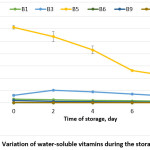 |
Figure 3: Variation of water-soluble vitamins during the storage period. |
Changes of minerals during the storage period
As can be seen in Table 3, a large number of minerals, including macrominerals (including Na: 146.50±8.91, K: 451.34±9.20, Ca: 915.05±29.81, P: 364.87±15.06, and Mg: 703.41±13.57 mg/100 g dry weight (DW), respectively) and microminerals (including Mn: 691.76±30.82, Zn: 5.53±0.56, Fe: 14.88±1.29, and Cu: 4.39±0.57 mg/100 g DW, respectively) have been found in the fresh leaves of S. androgynous plant. Correlating mineral values of macrominerals Na, K, Ca, P, Mg were 306.3±52.8, 45.7±1.5, 84.2±8.1, 61.2±3.5, 664.9±38.1 and microminerals Mn, Zn, Fe were 25.6±5.8, 15.9±6.6, 212.15±20.8 mg/100g DW were reported in the study of the authors from Malaysia. But in this study, the element Cu was not found. 5 The mineral levels in the study were significantly different from our research.
The following factors may explain the above difference. First of all, it is widely recognized that the climate and geographical features can influence the nutritional value of green leafy vegetables in general and the mineral content in particular. Furthermore, previous research has pointed out the difference in mineral concentration results between studies based on the variation of eleven mineral elements in leafy plants, including N, P, K, Ca, Mg, S, Si, Fe, Na, and Mn, and Al. According to an exhaustive investigation, the concentrations of these elements are influenced by latitude and longitude, climate, soil, and plant functional patterns. A comprehensive study was carried out on 1900 species of higher Earth plants, 788 and 175 families, at 752 locations throughout China. Specifically, most minerals increased gradually from South to North and decreased from East to West. Precipitation rates are more critical for enriching all elements (except phosphorus and aluminium) than temperature. Terrestrial plants absorb most nutrient minerals directly from the soil, so soil chemical properties (pH and mineral nutrient availability) are essential for plant growth and influence mineral concentrations. 20
Table 3: The mineral content of S. androgynous leaves during the storage period.
| Minerals(mg/100g DW) | Time of storage (days) | ||||
| 0 | 2 | 4 | 6 | 8 | |
| Na | 146.5±8.91e | 112.15±3.10d | 89.56±16.43cd | 74.93±8.62ab | 56.44±5.44a |
| K | 451.34±9.2c | 371.28±19.57b | 329.92±28.35b | 233.95±9.54a | 196.11±14.2a |
| Ca | 915.05±29.81d | 754.52±22.88c | 522.07±19.68b | 468.52±24.96b | 390.73±31.03a |
| P | 364.87±15.06c | 349.66±17.48c | 283.32±0.92b | 276.83±8.27b | 228.75±5.38a |
| Mg | 703.41±13.57e | 649.35±19.54d | 532.36±11.05c | 480.64±28.64b | 421.13±8.13a |
| Mn | 691.76±30.82d | 529.96±13.97c | 393.75±8.28b | 359.22±10.9ab | 313.75±26.11a |
| Zn | 5.53±0.56b | 3.69±0.56ab | 3.6±0.31ab | 2.99±0.33a | 1.58±1.94a |
| Fe | 14.88±1.29c | 11.7±1.34b | 10.74±1.17ab | 10.52±0.92ab | 8.39±0.98a |
| Cu | 4.39±0.57a | 3.83±0.75a | 3.09±0.78a | 2.99±0.64a | 2.84±1.07a |
Mean ± SD representation value of 3 replicates. Different letters in same row indicate significant differences among different treatments (P < 0.05).
When compared to other fresh green leafy vegetables, the mineral content in the leaves of S. androgynous was significantly higher than the reported in another study (such as Ipomoea aquatica plant, the levels of these minerals such as macrominerals Na, K, Ca, and Mg were: 0.840±0.004, 4.406±0.001, 5.983±0.002, 0.044±0.001, and microelements Mn, Zn, Fe, and Cu were 0.042±0.003, 0.144±0.02, 0.144±0.02, 6.338±0.004 g/100 g DW, respectively; in the fresh leaves of Amaranthus viridis the level of these minerals were 0.104±0.003, 3.316±0.050, 5.736±0.012, 0.039±0.001, 0.415 ±0.002 g/100 g DW, respectively). 10 As a result of these findings, it is possible to conclude that the leaves of S. androgynous are considered a valuable source of nutrients providing many essential minerals for humans.
According to the research results (Figure 4, 5), essentially all of these macro- and microminerals tend to reduce after 8-days of storage in the refrigerator at a temperature of 6.2±2.89oC and moisture 49±13.23 %. At the end of the storage period, the content of macrominerals Na, K, Ca, P, Mg lost 61.47, 56.55, 57.30, 37.31, 40.13 %, respectively, and microminerals Mn, Zn, Fe, Cu lost 54.64, 71.35, 43.61, 35.45 %, respectively when compared with that of fresh leaf samples. The amount of most minerals after 8-days of storage dramatically decreased. Statistical analysis in Table 2 revealed that the quantity of Zn in storage has a significant change after 8 days, while the amount of Cu in storage has not changed significantly, despite the quantity of the element reducing compared to 0 days of storage.
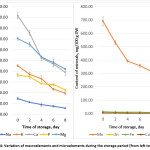 |
Figure 4: Variation of macro elements and microelements during the storage period (from left to right). |
Change of water-soluble vitamins and minerals of S. androgynous by method pretreatment before thermal processing
Vitamins
First of all, the change of water-soluble vitamins content in the S. androgynous leaf extract is presented in Figure 6 revealed that after boiling for 15 minutes, the quantity of vitamin B1, B3, B5, B6, B9, and C in rub samples lost 84.57, 86.45, 93.94, 100, 90.98, and 86.16 %, respectively. Furthermore, the level of these vitamins in “non-rub” leaf samples lost 95.26, 91.39, 91.34, 73.70, 91.24, and 71.63 %, respectively. Therefore, for all leaf samples, the content of the investigated vitamins (including vitamins B1, B3, B5, B6, B9 and C) were significantly lost in all of the leaf extracts (P < 0.05) compared to the initial leaf samples (as shown in Table 4).
It is well known that many of the B-group vitamins are sensitive to heat degradation. 1 Like B-group vitamins, vitamin C is a water-soluble vitamin and is not temperature stable, so it rapidly decomposes during moist heat treatment. Vitamin C is greatly lost when processed at high temperature and long heating time. A similar result was reported in the study previously ; 1 boiling destroyed vitamin C in almost all the samples, with nutrient retention ranging from 0 to 73.86%.
Table 4: The water-soluble vitamin content by method preparation.
| Vitamin(mg/100 mg DW) | Pretreatment method | ||
| Fresh leaves | Rub the leaves | Non-rub the leaves | |
| B1 | 62.69±16.02b | 9.67±2.02a | 2.97±0.82a |
| B3 | 123.39±19.45b | 16.78±12.24a | 10.63±0.24a |
| B5 | 1224.43±31.18b | 74.14±6.22a | 106.10±2.29a |
| B6 | 1.25±0.50b | 0.00±0.00a | 0.33±0.10ab |
| B9 | 27.21±9.20b | 2.46±0.41a | 2.83±0.30a |
| C | 7.26±0.78b | 1.00±0.21a | 2.06±0.08a |
Mean ± SD representation value of 3 replicates. Different letters in same row indicate significant differences among different treatments (P < 0.05)
The leaf samples of the two pretreatment methods after thermal processing were compared to fresh leaf samples. Firstly, the results in Figure 6 show that the “rub” pretreatment method seemed to have a more substantial impact on the content of survey vitamins in S. androgynous leaves. Nevertheless, on the other hand, as shown in Table 4, there was no statistical significance between the two pretreatment methods in the vitamin content of all leaf samples (P > 0.05).
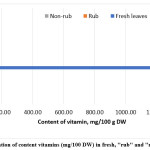 |
Figure 5: Variation of content vitamins (mg/100 DW) in fresh, ”rub” and ”non-rub” leaves. |
Minerals
Table 5: The mineral content by method pretreatment.
| Mineral (mg/100g DW) | Pretreatment method | ||
| Fresh leaves | Rub the leaves | Non-rub the leaves | |
| Na | 146.5±8.91b | 90.63±9.77a | 70.86±12.38a |
| K | 451.34±9.20c | 219.53±9.79a | 332.92±29.34b |
| Ca | 915.05±29.81b | 638.66±53.97a | 694.1±26.50a |
| P | 364.87±15.06b | 263.68±7.34a | 276.36±16.93a |
| Mg | 703.41±13.57c | 87.81±6.97a | 226.64±28.01b |
| Mn | 691.76±30.82b | 485.66±45.9a | 623.53±21.57b |
| Zn | 5.53±0.56c | 1.27±0.2a | 3.61±0.54b |
| Fe | 14.88±1.29b | 4.24±0.81a | 11.72±2.07b |
| Cu | 4.39±0.57b | 0.42±0.2a | 3.76±1.13b |
Mean ± SD representation value of 3 replicates. Different letters in same row indicate significant differences among different treatments (P < 0.05)
According to the research findings presented in Figure 6, almost all of these macrominerals, except for Ferrum (Fe) and Copper (Cu), tend to reduce both the “rub” and “non-rub” methods of pretreatment after boiling the plant leaves. The results showed that after cooking for 15 min when compared with fresh leaves samples, the number of macrominerals Na, K, Ca, P, and Mg in “rub” samples was 38.14, 51.36, 30.21, 27.73, 87.52%, and microelements Mn, Zn, Fe, and Cu were 29.79, 77.00, 71.52, 90.35% respectively. In contrast, the levels of these minerals in “non-rub” leaves samples were 51.63, 26.24, 24.15, 24.26, 67.78% and 9.86, 34.68, 21.23, 14.41%, respectively.
The results in Table 5 revealed that the minerals were significantly lost in most of the leaves’ extract after thermal processing (P < 0.05). A similar result was reported in a study by Korus, 1 which showed that minerals in kale leaves are significantly lost (24–52%) after the blanching processing.
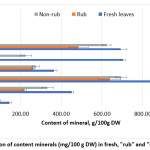 |
Figure 6: Variation of content minerals (mg/100 g DW) in fresh, “rub” and ”non-rub” leaves. |
The results of this study additionally showed that no significant differences (P > 0.05) between samples were pretreated in two different ways before thermal processing concerning mineral content (Na, Ca, and P). In contrast, for containing elements (K, Mg, Mn, Zn, Fe, and Cu), the level of these was significantly different (P < 0.05) when compared between method pretreatment “rub” and “non-rub”. Furthermore, for their elements (K, Mg, Mn, Zn, Fe, and Cu), the “rub” samples were more decreased than the “non-rub” leaf samples. There was no statistical difference between the “non-rub” sample and the fresh sample for element Cu.
The following are the reasons for vitamin and mineral loss during thermal processing. Thermal blanching cause significant loss of minerals and vitamins. This loss may be due to their thermal instability and/or to the leaching of these compounds in water. Leaching and diffusion are the leading causes of nutrient loss during hot water boiling.
Our results were more remarkable than research by Korus. 1 When rubbing, minerals such as calcium (Ca) decreased by nearly 30 %, magnesium (Mg) dropped by nearly 10 times (87.52 %), and potassium (K) decreased by 50 %. The more vital loss was concerning the rubbing process, which could destroy the cell membrane of the leaves and result in a higher loss of minerals. Furthermore, the rubbing process resulted in a higher loss of minerals than non-rub leaves, typically Fe, Zn, K, Cu, Mg, etc. Because of its high water solubility, potassium (K) is easily leached during water heat treatment, resulting in significant losses. Other minerals, such as Ca and Mg, are bound to plant tissue in fruits and vegetables, so the results of the two processing processes are nearly identical for these minerals. This observation was similar to research reported by Korus. 1
Conclusion
In summary, the most abundant macrominerals were K, Ca, and P, while Mg and Mn were the most abundant microelements. Additionally, the storage and thermal (boiling) process significantly reduced the water-soluble vitamins (B1, B5, B6, C) and minerals (Na, K, Ca, Mn, and Zn) content of S. androgynous leaves. The comparison of the change of vitamins and minerals by two pretreatment methods before thermal processing showed that the pretreatment “rub” method seemed not to influence the quantity of S. androgynous leaves most vitamins and several minerals, such as K, Mg, Mn, Zn, Fe, and Cu. Based on the above results, it can be concluded that the leaves of Sauropus androgynous are an excellent source of water-soluble vitamins and minerals among many green leafy vegetables. People need to know how to store and cook them to retain the essential micronutrients this rural vegetable species has endowed man.
Acknowledgements
We are grateful to Mrs Do Doan Dung, lecturer at the Institute of environmental science, engineering and management, for providing me with part of the necessary facilities for the research. Thank also to Mss Nguyen Thi Thanh Thao, an undergraduate student at the Institute of Biotechnology and Food Technology, for her incredible support during the whole process of this research.
Conflict of interest
All authors have declared no conflicts of interest for this article.
Funding Sources
Part of the research funding (worth 1,000 USD) was funded by the Industrial University of Ho Chi Minh City (IUH) to Dr Nguyen T. M. Nguyet. Dr Dang Thu Thuy and Dr Nguyen T. M. Nguyet provide the rest of the funding to balance their expenses.
References
- Korus A. Changes in the content of minerals, B-group vitamins and tocopherols in processed kale leaves. Journal of Food Composition and Analysis. 2020;89:103464.
CrossRef - Zhang B. D., Cheng J. X., Zhang C. F, Bai Y. D., Liu W. Y., Liu W., Koike K., Akihisa T., Feng F., Zhang J. Sauropus androgynus L. Merr.-A phytochemical, pharmacological and toxicological review. Journal Ethnopharmacol. 2020;257:112778.
CrossRef - Petrus A. Sauropus androgynus (L.) Merrill-a potentially nutritive functional leafy-vegetable. Asian Journal of Chemistry. 2013;25(17):9425-9433.
CrossRef - Kim J. H., Park J. G., Hong Y. H., Shin K. K., Kim J. K., Kim Y. D., Yoon H. D., Kim K. H. Sauropus brevipes ethanol extract negatively regulates inflammatory responses in vivo and in vitro by targeting Src, Syk and IRAK1. Pharm Biol. 2021;59(1):74-86.
CrossRef - Khoo H. E., Azlan A., Ismail A. Sauropus androgynus leaves for health benefits: hype and the science. The Natural Products Journal. 2015;5:115-123.
CrossRef - Fikri F., Purnama M. T. E. Pharmacology and phytochemistry overview on Sauropus androgynous. Systematic Reviews in Pharmacy. 2020;11(6):124-128.
CrossRef - Bunawan H., Bunawan S. N., Baharum S. N., Noor N. M. Sauropus androgynus (L.) Merr. Induced Bronchiolitis Obliterans: From Botanical Studies to Toxicology. Evid Based Complement Alternat Med. 2015;2015:714158-714158.
CrossRef - Mustarichie R., Salsabila T., Iskandar Y. Determination of the Major Component of Water Fraction of Katuk (Sauropus androgynous (L.) Merr.) Leaves by Liquid Chromatography-Mass Spectrometry. J Pharm Bioallied Sci. 2019;11(Suppl 4):S611-S618.
CrossRef - Mohan S., Bose R., Kumar M. S., Manivel A. Chemical Constituents of Sauropus androgynus and Evaluation of its Antioxidant Activity. Research Journal of Phytochemistry. 2018;12:7-13.
CrossRef - Datta S., Sinha B. K., Bhattacharjee S., Seal T. Nutritional composition, mineral content, antioxidant activity and quantitative estimation of water soluble vitamins and phenolics by RP-HPLC in some lesser used wild edible plants. Heliyon. 2019;5(3):e01431.
CrossRef - AOAC. Official methods of analysis. Association of Official Analytical Chemists, seventeenth ed Washington DC, Arlington, Virginia, USA. 2000.
- Udousoro I..I, Ekop R.U., Udo E.J. Effect of thermal processing on antinutrients in common edible green leafy vegetables grown in Ikot Abasi, Nigeria. Pakistan Journal of Nutrition. 2013;12(2):162.
CrossRef - Ciulu M., Solinas S., Floris I., Panzanelli A., Pilo M. I., Piu P. C., Spano N., Sanna G. RP-HPLC determination of water-soluble vitamins in honey. Talanta. 2011;83(3):924-929.
CrossRef - Hana R. A., Hope K., Emmanuel A., Tsdale M., Austin J. T., Carol M. B., , Sayo O. F. Determination of macro, essential trace elements, toxic heavy metal concentrations, crude oil extracts and ash composition from Saudi Arabian fruits and vegetables having medicinal values. Arabian Journal of Chemistry. 2017;10(7):906-913.
CrossRef - Kılıç Altun S., Dinç H., Paksoy N., Temamoğulları F. K., Savrunlu M. Analyses of Mineral Content and Heavy Metal of Honey Samples from South and East Region of Turkey by Using ICP-MS. Int J Anal Chem. 2017;2017:6391454.
CrossRef - Singh S., Singh D. R., Salim K. M., Srivastava A., Singh L. B., Srivastava R. C. Estimation of proximate composition, micronutrients and phytochemical compounds in traditional vegetables from Andaman and Nicobar Islands. Int J Food Sci Nutr. 2011;62(7):765-773.
CrossRef - Marles R. J. Mineral nutrient composition of vegetables, fruits and grains: The context of reports of apparent historical declines. Journal of food composition and analysis. 2017;56:93-103.
CrossRef - Santos J., Mendiola J. A., Oliveira M. B., Ibáñez E., Herrero M. Sequential determination of fat- and water-soluble vitamins in green leafy vegetables during storage. J Chromatogr A. 2012;1261:179-188.
CrossRef - Goyer A., Picard M., Hellmann H. A., Mooney S. L. Effect of low-temperature storage on the content of folate, vitamin B(6) , ascorbic acid, chlorogenic acid, tyrosine, and phenylalanine in potatoes. J Sci Food Agric. 2019;99(10):4842-4848.
CrossRef - Han W. X., Fang J. Y., Reich P. B., Ian Woodward F., Wang Z. H. Biogeography and variability of eleven mineral elements in plant leaves across gradients of climate, soil and plant functional type in China. Ecol Lett. 2011;14(8):788-796.
CrossRef

This work is licensed under a Creative Commons Attribution 4.0 International License.







